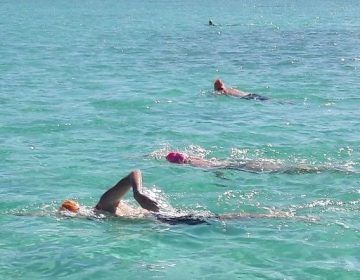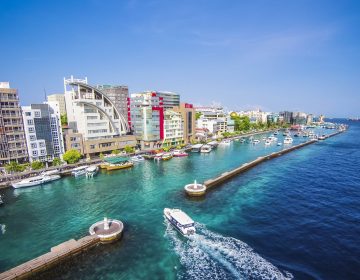North Nilandhe Atoll is shaped like a kidney and is 30 kilometers long and 25 kilometers wide. There are five inhabited islands with the capital being Nilandhoo and 15 densely vegetated uninhabited islands. Filitheyo is the only resort in the atoll and transfers are made mostly by seaplane to Dhigarvaru Falhu, three kilometers northwest of the resort. North and South Nilandhe Atolls are separated by a four-kilometer-wide channel, and regular contact between the islanders from the two atolls links the people closely in family and tradition. It is an atoll of historical importance that once produced the most skilled sailors who contributed significantly to trading with the Maldives and abroad. Travel experiences to these two atolls are rewarding, partly because of the isolation of the resorts, the large number of spectacularly vegetated uninhabited islands and the historical interest of the islands.

Nilandhoo
Nilandhoo is the capital island of the atoll and also the most populated. It replaced Magoodhoo as the capital in 1999. Nila means blue and could refer to the big blue lagoon within the reef. There is a new harbor and atoll administration buildings on the western side of the island. The island has a fine beach on the southern side. Nilandhoo is an ancient inhabited island, and archaeological evidence at a 200-meter square site known as ‘Foamathi’ suggests it was one of the most sacred pre-Islam sites in the archipelago. Foa means areca nut, and many Maldivians chew it, but it also means testicle. According to oral tradition, Foamathi had seven temples that were demolished soon after the arrival of Islam in AC 1153. The local people refer to the site as Aasaaree Sarahadholhu or Ancient Place, and it is believed the people were once Buddhist or maybe even Hindu.
At the time of conversion, they were reluctant to give up their old religion, so the first Sultan, Muhammed-ul-Adil, went to the island with soldiers and set up a temporary palace to deal with the strong following of worshippers. One street is called Bodu Ganduvaru Magu, meaning big palace street. All the temples, except the gateways, were destroyed, idols were broken or buried and a new mosque, the second in the Maldives, was built on the site of the seventh temple with much of the stonework coming from the original temples. The mosque has since been rebuilt, but some of the existing elaborate coral stones used in the temples are still in evidence. The gateway to the seventh temple still stands in front of the mosque, but the remaining six were demolished sometime in the 1950s when little value was placed on archaeological sites.
 Nilandhoo Island
Nilandhoo Island
Dharaboodhoo
Dharaboodhoo is an island where religious relics have also been found. The island was famous as a breeding place for turtles. One man said that 30 years ago up to 40 turtles would come on the island to nest every night, but now it is now very rare to see them. Islanders are not allowed to kill turtles, but they are allowed to take eggs.
Magoodhoo
Magoodhoo was the first capital of the atoll and used to be called Fonimagoodhoo. Foni means sweet.
 Magoodhoo Island
Magoodhoo Island
Magoodhoofinolhu
Magoodhoofinolhu is a small nearby uninhabited island.
Biledhdhoo
Biley is the betel leaf used when chewing areca nut and the island has many betel vines growing on it, as well as Breadfruit trees. The Islanders are regarded as good fishermen and a new harbor finished in 1999 offers good protection for the dhonis. Like most of the inhabited island, it has long, clean sandy streets, mostly running east and west and telephone booth and streetlights were constructed in 1999. The island office is marked by a flagpole flying the National Flag and is located in the traditional position, not far from the waterfront near the harbor. The island has an old mosque that was built on top of a Buddhist monastery. It was enlarged in 1999, but the small, beautifully constructed old mosque with its white slabs of coral and intricately carved wooden inner walls, still remain intact within the larger building. The stone foundations of the old monastery can be seen sticking out at angles from the base, as the mosque now faces Mecca and not east/west. The ancient well is lined with coral slabs and the water crystal clear. There are old tombs nearby and an ancient bath with steps, now filled with coral and sand. Future excavations should reveal a lot more about this history of the island.
Adhangau
Adhangau is a small uninhabited island.
Embulufushi
Embulufushi is a small uninhabited island. An embulu is a creeper with a small sweet fruit that children like to eat. The plant and fruit are also used as herbal medicine.
Maavaruhuraa
Maavaruhuraa is a long uninhabited island located at the northern end of a big reef.
Jinnathugau
Jinna means fairy, and the island name translates as ‘the stone which the fairy came and stood on.’
Filitheyo
Filitheyo is a large island that was once inhabited a long time ago. It opened as a resort in 1999 and is currently the only resort in the atoll. Gravestones and other relics can be found at a small cemetery located 50 meters behind the reception area among the dense vegetation. There are about ten headstones still visible among the vegetation, including the tomb of ‘Ismail.’ He is an unknown person but nevertheless formerly considered ‘holy’ as many islanders used to leave little white flags and other items at his tomb to bring good luck. There are also the remains of a mosque located nearby, but the foundations are now mostly covered in trees and scrubs.
The island became uninhabited in the early 1900s but used to have a flagpole for many years after. When a white flag was flying, it indicated someone was staying at huts on the island. When there was no flag, then the island was unoccupied. In 1917, two English officers, Lieutenants Meade and Smith, were on a reconnaissance mission in a seaplane from H.M.S. Raven when it ran into difficulties and was forced down near Filitheyo. The officers swam through 2.5 kilometers of shark-infested waters to reach this island. The seaplane was found floating about Feeali.
 Filitheyo Island Resort
Filitheyo Island Resort
The Tomb of Filitheyo Ismail
At some time, someone of note was buried on Filitheyo. No knows for sure who it was, but the tomb of ‘Ismail’ as it became known, has become a part of Faafy legend. Until recently, people paid their respects and prayed at Ismail’s tomb. They made offerings such as food and placed little white flags to bring good luck. At sunset, travelers from Nilandhoo stopped at the tomb to pray for good fortune during their often hazardous sailing journey to Malé.
One lady from Bilendhdhoo said she placed a white flag at the tomb after the birth of her son. She pointed out proudly that her son, then 19, was top of his class at school.
People often make up stories for the deceased, and one story about ‘Ismail’ has immortalized his tomb. Some people claim he was a Kanverin, or magician, from Vaadhoo in Gaafu Dhaalu who died while at sea near Filitheyo. The fishing grounds off Filitheyo are well known and large schools of ‘Ran Korakali,’ small golden fish, can be seen there glistening in the morning sun. This picturesque site is attributed to ‘Ismail’s’ magical powers.
As a sign of Ismail’s reputation, all dhonis coming from Malé or elsewhere, steered away from the channels on either side of Filitheyo Island, preferring the channels further north or south. This sailing practice is still continued by many fishermen today.
Faanuvaahuraa
Faanuvaahuraa is a small uninhabited island.
Maafushi
Maafushi is a small uninhabited island.
Dhiguvarufinolhu
Dhiguvarufinolhu is a long sandy island.
Madivaruhuraa
Madivaruhuraa means Ray Island.
Viligilivarufinolhu
Viligilivarufinolhu is a tiny uninhabited island but may have once been inhabited. Varu is a group of people or varu can also be a place on the reef where waves break.
Fieeli
Fieeli is an uninhabited island. Fiee means rotten while ali is a light. The name translates as ‘dim light island’. There is a 45-meter communications tower on it and on the south side of Fieeli Kandu is a sizeable light beacon, indicating the channel through which many of the atoll boats pass.
Makunueri
Makunueri is an uninhabited island inside the atoll. Makunu means monkey and eri means came. In the past, sailors may have arrived at this island with many monkeys.
Kadumoonufushi
Kadumoonufushi means the island on the edge of the channel. It is a small uninhabited island at the northern tip of the atoll.
Himithi
This island was inhabited until 1970 and used to be the capital of the atoll. On April 12, 1977, a French vessel the Duras was wrecked on this island fully laden with cargo on a voyage to Pondicherry. All the shipwrecked folk met with the kindest treatment from the islanders of the atoll. The passengers and crew were transferred to Malé where they stayed for two weeks before being sent to India. One of the passengers was the wife of the French administrator of Pondicherry who was preceding him to India. The Sultan of the Maldives, Muhammed Mu’izz-ud-din, salvaged what was left of the ship and with that he built a robust new boat of about 200 tons that continued to sail to the coast of Coromandel and to Orissa for many years.
On Himithi lies the tomb of Sheikh ‘boa-huni’ Alibay and the remains of a thulhu-dhandi, or set of wooden scales that were used in a ceremony to bring good luck to the newly born. Sheikh Alibay’s favorite food was ‘boa-huni,’ a sweet made of coconut and honey, so for good luck, the newly born was placed on one end of the scale and balanced by ‘boa-huni’ at the other. The dish was then distributed to the Islanders.
The island of Himithi is continuously ‘moving’ as heavy erosion, and deposition of sand takes place. A story told over previous generations is that a sandbank would one day emerge near Himithi and when it joined the island, the people would leave. This sandbank did in fact form to the north of the island and joined the main island in 1960. Ten years later the island became uninhabited. The story also foretold that the people would one day return to live on the island, but when that happens, the world will end!
 Himithi Island
Himithi Island
Minimasgali
Minimasgali is a small uninhabited island near the eastern side of Himithi. It is protected by reefs and was a favored anchoring place for large vessels that used to operate out of Himithi.
Himithi Sailors
The island of Himithi was renowned for the skill of its sailors and their teaching of navigation and mathematics. It was here, during his survey of the islands in 1834 that Captain Robert Morseby mentions the island as having a school for navigation. Around this time, there were seven large Odis and Baggalas, 70 to 80 feet long and owned by the Maldivian Government that sailed to more distant places such as Bangladesh, India, Sri Lanka and Oman. During rough weather, they anchored off the nearby island of Minimasgali, where the reefs offer excellent protection. One of the most famous mathematicians was Abdulla Ismail Kalafan, whose nickname was Tutu.
He went abroad to study in Calcutta and the story told is that he became fascinated with the Almanac, a book used by navigators to study the position of stars and planets. While making his own calculations, he noticed a mathematical error and pointed this out to the English authorities. They were most defensive and ordered him before the Almanac committee to explain his calculations or ‘he would be shot,’ so the story goes. After he convinced the committee that an error had been made and showed them the corrections, they all stood up, tilted their hats and called ‘Sir Tutu.’ Sir Tutu returned to the Maldives with a lifelong commission and greatly enhanced reputation after winning the respect of the British.
Another famous sailor was Boduge Hawwaa, a woman of considerable standing in the community because she owned a large boat and was the head of a large dwelling where 40 people lived. On one trip from Malé to Himithi, her ship as sailing home via Felidhe Atoll – the customary route – when she ordered the boat to anchor securely at Fussaru Falhu. She also ordered a thatched roof built over the ship for protection even though the weather was fine. When the crew asked her why this was being done, she replied: “Don’t ask me why. This vessel is mine, and you’ll do as I say!” Before long, the weather turned bad, and a violent storm thrashed the boat. As soon as it started to ease, she ordered the anchors up and set sail even before the storm had dropped. Soon the weather was clear again, and the ship traveled on uninterrupted to Himithi. The crew was most impressed, and stories of Boduge Hawwaa’s sailing exploits became legendary.
(Source: Dive Maldives: A guide to the Maldives Archipelago. Tim Godfrey. Atoll Editions)



